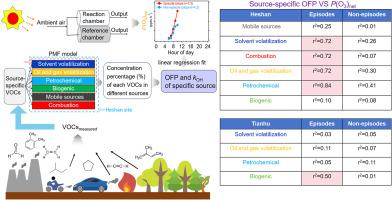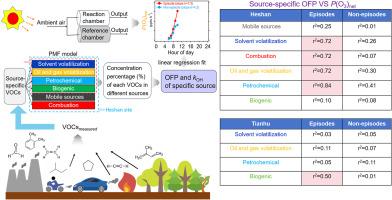珠江三角洲特定臭氧来源的形成:两个环境特征不同地点的直接测量结果
IF 7.3
2区 环境科学与生态学
Q1 ENVIRONMENTAL SCIENCES
引用次数: 0
摘要
臭氧(O3)前体挥发性有机化合物(VOCs)表现出区域和来源相关的变异性。由于不完整的反应机制,目前的模型往往低估了O3的产生,这突出了对直接测量技术的需求,以量化光化学O3。本研究利用定制的净光化学O3生产速率(NPOPR)检测系统,在珠江三角洲(PRD)地区具有不同环境特征的两个站点:中国广东省鹤山大气超级站点(鹤山站点)和天湖大气环境监测站(天湖站点)测量了净光化学O3生产速率(P(O3)net)。利用正矩阵分解(PMF)模型,我们确定了两个地点的溶剂挥发、油气挥发、石化释放和生物源,而移动源和燃烧源仅在鹤山地点确定。然后,我们将不同VOCs排放源的O3形成势(OFP)和VOC反应性(kOH)直接与测量的P(O3)净联系起来。结果表明:河山遗址P(O3)净的人为源包括溶剂挥发、燃烧、油气挥发和石油化工;与此相反,生物源排放在天湖站点驱动P(O3)净。结果反映了不同环境点瞬时光化学O3形成的不同优势排放源。需要进一步的定量方法来确定这两个站点的主要O3污染来源。实施因地制宜的污染源排放控制措施,对O3污染防治具有重要意义。本文章由计算机程序翻译,如有差异,请以英文原文为准。


Source-specific ozone formation in the Pearl River Delta: Insights from direct measurement at two sites with distinct environmental characteristics
Ozone (O3) precursor volatile organic compounds (VOCs) show region- and source-dependent variability. Current models often underestimate O3 production due to incomplete reaction mechanisms, highlighting the need for direct measurement techniques to quantify the photochemical O3. In this study, we measured net photochemical O3 production rate (P(O3)net) at two sites with distinct environmental characteristics in the Pearl River Delta (PRD) region using a custom-made Net Photochemical O3 Production Rate (NPOPR) detection system: the Guangdong Atmospheric Supersite of China in Heshan (Heshan site) and the Tianhu Atmospheric Environment Monitoring Station (Tianhu site). By using a Positive Matrix Factorization (PMF) model, we identified solvent volatilization, oil and gas volatilization, petrochemical releases, and biogenic sources at both sites, while mobile and combustion sources were only identified at the Heshan site. We then linked the O3 formation potential (OFP) and VOC reactivity (kOH) of different VOCs emission sources directly to the measured P(O3)net. Results showed that anthropogenic sources drove P(O3)net at Heshan site, including solvent volatilization, combustion, oil and gas volatilization, and petrochemical. In contrast, biogenic emissions drove P(O3)net at the Tianhu site. The results reflect the different dominant emission sources in instantaneous photochemical O3 formation at distinct environmental sites. Further quantitative methods are needed to check the dominate contributing sources to the O3 pollution at these two sites. It is of great significance to implement pollution source emission control measures that are tailored to local conditions for the prevention and control of O3 pollution.
求助全文
通过发布文献求助,成功后即可免费获取论文全文。
去求助
来源期刊

Environmental Pollution
环境科学-环境科学
CiteScore
16.00
自引率
6.70%
发文量
2082
审稿时长
2.9 months
期刊介绍:
Environmental Pollution is an international peer-reviewed journal that publishes high-quality research papers and review articles covering all aspects of environmental pollution and its impacts on ecosystems and human health.
Subject areas include, but are not limited to:
• Sources and occurrences of pollutants that are clearly defined and measured in environmental compartments, food and food-related items, and human bodies;
• Interlinks between contaminant exposure and biological, ecological, and human health effects, including those of climate change;
• Contaminants of emerging concerns (including but not limited to antibiotic resistant microorganisms or genes, microplastics/nanoplastics, electronic wastes, light, and noise) and/or their biological, ecological, or human health effects;
• Laboratory and field studies on the remediation/mitigation of environmental pollution via new techniques and with clear links to biological, ecological, or human health effects;
• Modeling of pollution processes, patterns, or trends that is of clear environmental and/or human health interest;
• New techniques that measure and examine environmental occurrences, transport, behavior, and effects of pollutants within the environment or the laboratory, provided that they can be clearly used to address problems within regional or global environmental compartments.
 求助内容:
求助内容: 应助结果提醒方式:
应助结果提醒方式:


